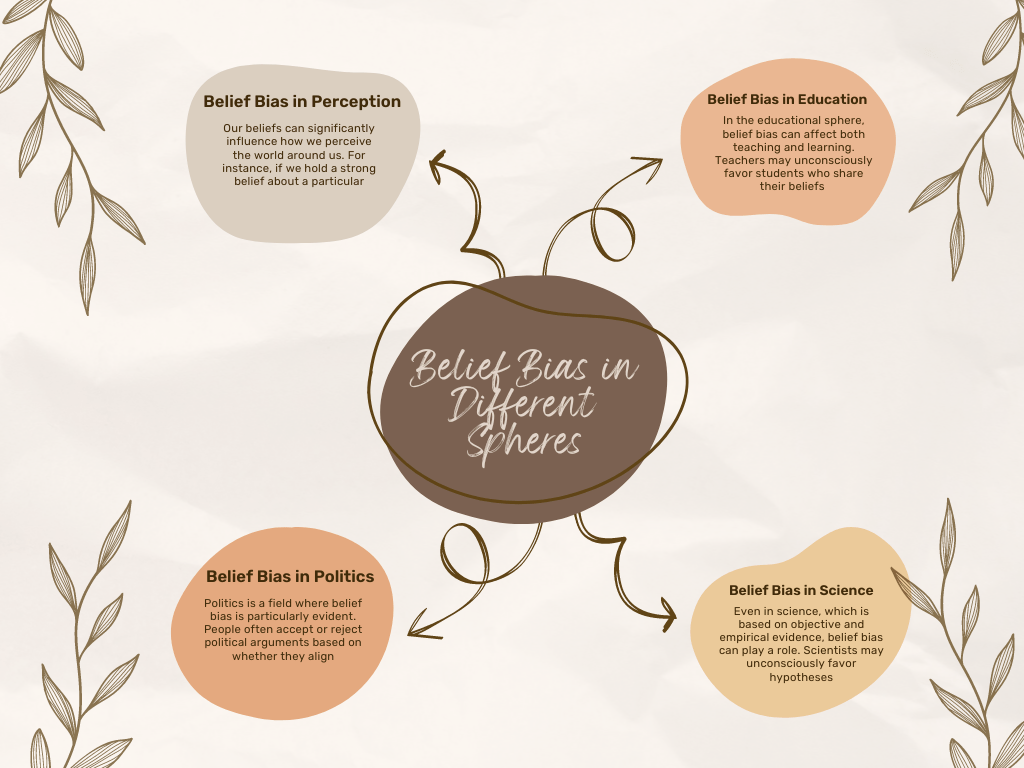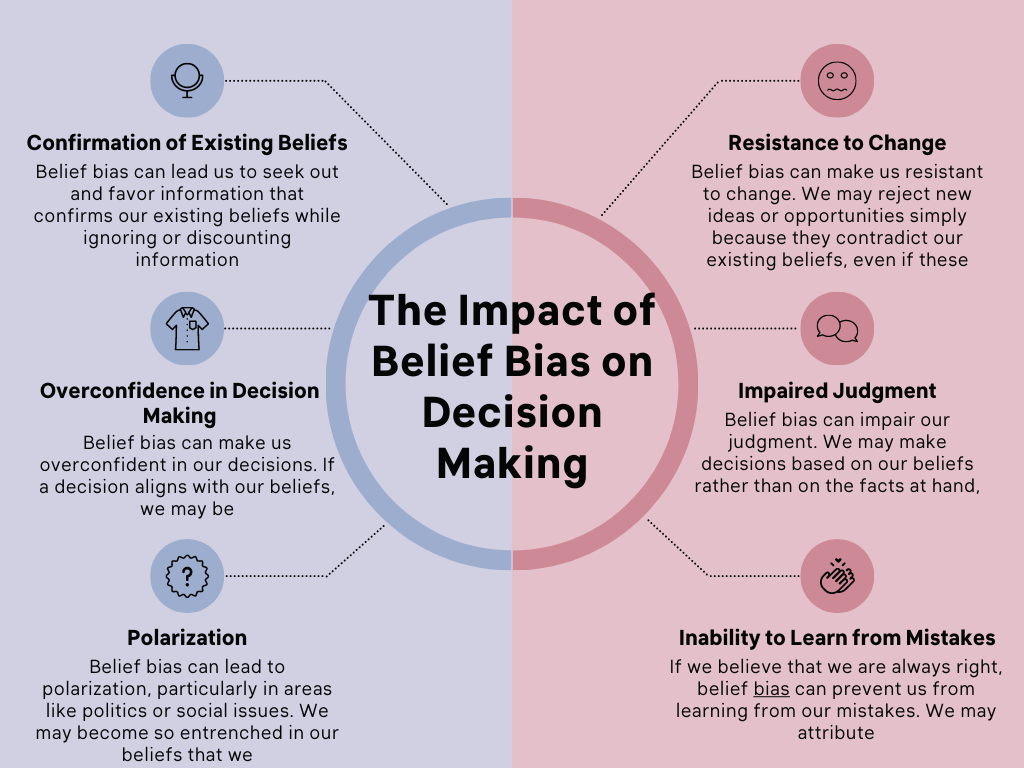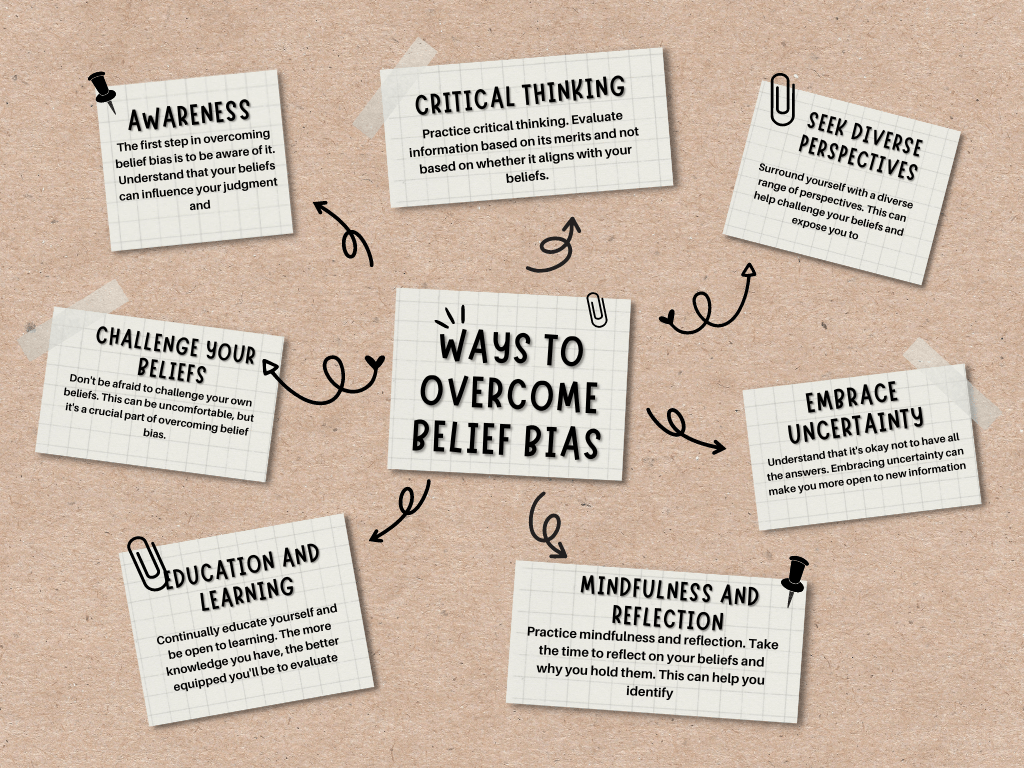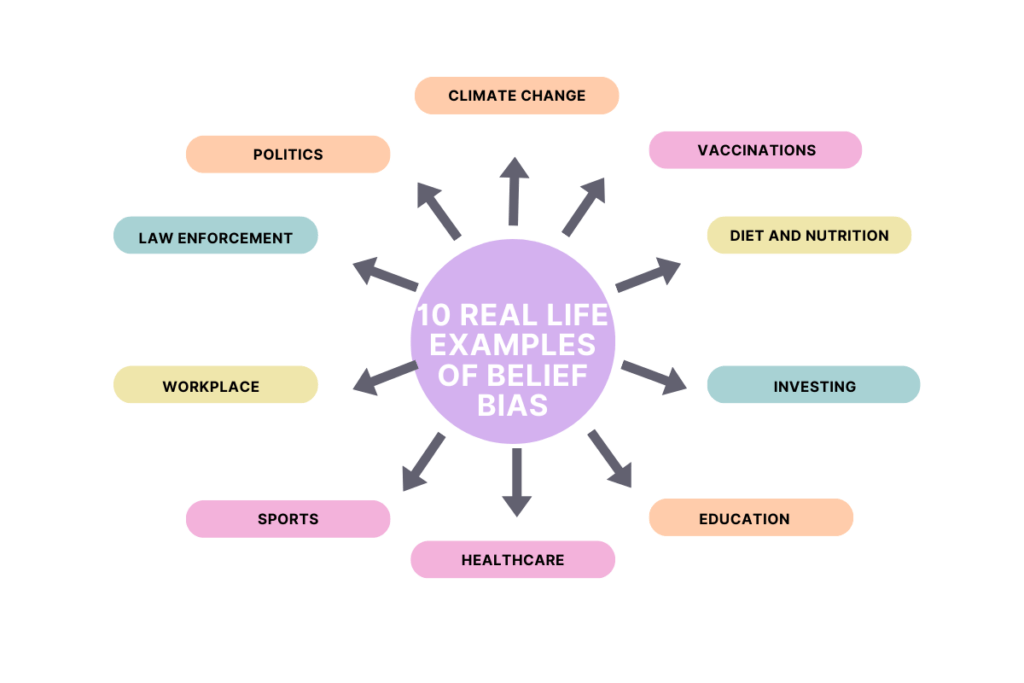Introduction
Definition of Belief Bias
Belief Bias is a psychological phenomenon that influences our logical thinking and decision-making processes. It is a cognitive bias that leads us to accept or reject arguments based on whether we agree or disagree with the conclusion, rather than on the strength or validity of the argument itself. In other words, our pre-existing beliefs and perceptions can cloud our judgment and skew our ability to objectively evaluate information.
This bias is deeply rooted in our cognitive system and plays a significant role in how we interpret and react to the world around us. It can affect various aspects of our lives, from our personal relationships to our professional decisions, and even our political and educational views.
10 Real-Life Examples of Belief Bias

Climate Change: Some people may reject scientifically sound evidence of climate change because it contradicts their pre-existing beliefs or political ideologies.
Vaccinations: Despite numerous studies showing the safety and effectiveness of vaccines, some individuals refuse to believe in their benefits due to pre-existing beliefs, often leading to public health issues.
Diet and Nutrition: People often hold strong beliefs about what constitutes a healthy diet. They may reject well-researched nutritional advice if it contradicts their existing beliefs about certain foods or diets.
Investing: An investor might stick to a failing investment strategy because they believe it will eventually pay off, ignoring evidence to the contrary.
Education: A teacher might believe that a particular student is academically weak based on a single poor performance, leading them to interpret all of the student’s future performances in a negative light.
Healthcare: A person might ignore a doctor’s advice to quit smoking because they believe that they won’t be affected by the health risks associated with smoking.
Sports: A football coach might continue to favor a player who has performed well in the past, even if the player’s current performance is not up to the mark.
Workplace: An employer might overlook a qualified candidate for a job because they hold a bias against the candidate’s race, gender, or background.
Law Enforcement: A police officer might interpret a person’s actions as suspicious because they hold a bias against the person’s race or ethnicity.
Politics: A person might support a political policy that is not in their best interest because it aligns with their political beliefs, ignoring evidence that suggests the policy might be harmful.
A brief overview of the concept
The Psychology of Belief Bias
Explanation of how belief bias works
Belief bias is a fascinating and complex phenomenon deeply rooted in our cognitive processes. It operates on the principle that our beliefs, whether they are based on personal experiences, cultural norms, or societal influences, can significantly impact our logical reasoning. When faced with an argument or a piece of information, we tend to judge its validity not on its inherent logical structure but on whether its conclusion aligns with our pre-existing beliefs.
For instance, if we strongly believe in a particular concept, we are more likely to accept an argument that supports this concept, even if the argument itself is logically flawed. Conversely, we may reject a logically sound argument if its conclusion contradicts our beliefs. This bias towards our beliefs can lead us to make decisions that are not based on objective reasoning but are instead influenced by our subjective perceptions and biases.
The role of cognitive psychology in belief bias
Cognitive psychology plays a crucial role in understanding belief bias. Cognitive psychologists study how people perceive, think, remember, and learn, and belief bias falls within this realm of study. It is considered a ‘heuristic’ or a mental shortcut that our brain uses to make decision-making easier. While heuristics can be beneficial in many situations, they can also lead to cognitive biases like belief bias, which can distort our understanding and reasoning.
Belief bias is also closely linked to the concept of ‘cognitive dissonance’, a term coined by social psychologist Leon Festinger. Cognitive dissonance refers to the mental discomfort we experience when we hold two or more contradictory beliefs or when our beliefs are challenged by new information. To reduce this discomfort, we may reject or ignore the new information, further reinforcing our belief bias.
Understanding the psychology of belief bias is the first step towards recognizing its influence in our lives and finding ways to mitigate its effects. In the following sections, we will explore the different types of belief bias and how they manifest in various spheres of life.
Difference Between Belief Bias and Confirmation Bias
| Belief Bias | Belief Bias | Cognitive Bias |
| Definition | Belief Bias is a specific type of cognitive bias where one’s beliefs affect the logical reasoning process, leading to acceptance or rejection of arguments based on alignment with existing beliefs rather than on their logical validity. | Cognitive Bias is a broader term that refers to systematic errors in thinking that affect the decisions and judgments that people make. It’s a general term for many types of biases in our thinking. |
| Examples | If a person believes strongly in a particular diet, they might reject a well-researched study that contradicts their belief, even if the study is logically sound. | Confirmation bias (favoring information that confirms one’s existing beliefs), anchoring bias (relying too heavily on the first piece of information encountered), and availability heuristic (relying on immediate examples that come to mind when evaluating a specific topic) are examples of cognitive biases. |
| Impact | Cognitive biases can distort perception, lead to inaccuracies in decision-making, and limit the effectiveness of problem-solving. | Confirmation bias (favoring information that confirms one’s existing beliefs), anchoring bias (relying too heavily on the first piece of information encountered), and availability heuristics (relying on immediate examples that come to mind when evaluating a specific topic) are examples of cognitive biases. |
| Overcoming | Overcoming belief bias involves recognizing and challenging one’s own beliefs and being open to logical arguments even if they contradict existing beliefs. | Overcoming cognitive biases often involves awareness of the biases, critical thinking, and decision-making strategies that take these biases into account. |
Belief Bias in Different Spheres

Belief Bias in Perception: Our beliefs can significantly influence how we perceive the world around us. For instance, if we hold a strong belief about a particular group of people, we might perceive their actions in a way that confirms our beliefs, even if an objective observer might interpret the same actions differently. This can lead to stereotypes and prejudices.
Belief Bias in Education: In the educational sphere, belief bias can affect both teaching and learning. Teachers may unconsciously favor students who share their beliefs or values, and students may resist learning new concepts that contradict their pre-existing beliefs. This can hinder the objective dissemination and acquisition of knowledge.
Belief Bias in Politics: Politics is a field where belief bias is particularly evident. People often accept or reject political arguments based on whether they align with their political beliefs, rather than on the merits of the arguments themselves. This can lead to polarization and a lack of constructive dialogue.
Belief Bias in Science: Even in science, which is based on objective and empirical evidence, belief bias can play a role. Scientists may unconsciously favor hypotheses that align with their beliefs and may be reluctant to accept evidence that contradicts these beliefs. This can hinder scientific progress and lead to biased research findings.
The Impact of Belief Bias on Decision Making
How belief bias affects our decisions
Belief bias has a profound impact on our decision-making processes. It can lead us to make decisions based on our pre-existing beliefs and perceptions, rather than on objective evidence or logical reasoning. Here’s how it affects our decisions:

Confirmation of Existing Beliefs: Belief bias can lead us to seek out and favor information that confirms our existing beliefs while ignoring or discounting information that contradicts them. This can result in a skewed perception of reality and can lead to poor decision making.
Resistance to Change: Belief bias can make us resistant to change. We may reject new ideas or opportunities simply because they contradict our existing beliefs, even if these new ideas or opportunities could be beneficial.
Overconfidence in Decision Making: Belief bias can make us overconfident in our decisions. If a decision aligns with our beliefs, we may be overly confident about its correctness, even if there is evidence to suggest otherwise.
Impaired Judgment: Belief bias can impair our judgment. We may make decisions based on our beliefs rather than on the facts at hand, leading to potentially harmful outcomes.
Polarization: Belief bias can lead to polarization, particularly in areas like politics or social issues. We may become so entrenched in our beliefs that we are unable to see the merits of opposing viewpoints, leading to division and conflict.
Inability to Learn from Mistakes: If we believe that we are always right, belief bias can prevent us from learning from our mistakes. We may attribute failures to external factors rather than recognizing our own errors in judgment.
Ways to Overcome Belief Bias

Awareness: The first step in overcoming belief bias is to be aware of it. Understand that your beliefs can influence your judgment and decision-making processes.
Critical Thinking: Practice critical thinking. Evaluate information based on its merits and not based on whether it aligns with your beliefs. Ask questions, seek evidence, and don’t accept arguments at face value.
Seek Diverse Perspectives: Surround yourself with a diverse range of perspectives. This can help challenge your beliefs and expose you to different ways of thinking.
Embrace Uncertainty: Understand that it’s okay not to have all the answers. Embracing uncertainty can make you more open to new information and less likely to cling to your beliefs in the face of contradictory evidence.
Mindfulness and Reflection: Practice mindfulness and reflection. Take the time to reflect on your beliefs and why you hold them. This can help you identify any biases in your thinking.
Education and Learning: Continually educate yourself and be open to learning. The more knowledge you have, the better equipped you’ll be to evaluate information objectively.
Challenge Your Beliefs: Don’t be afraid to challenge your own beliefs. This can be uncomfortable, but it’s a crucial part of overcoming belief bias.
Samrat is a Delhi-based MBA from the Indian Institute of Management. He is a Strategy, AI, and Marketing Enthusiast and passionately writes about core and emerging topics in Management studies. Reach out to his LinkedIn for a discussion or follow his Quora Page

